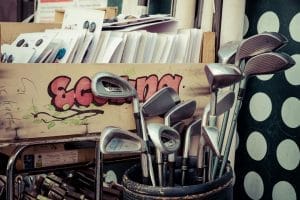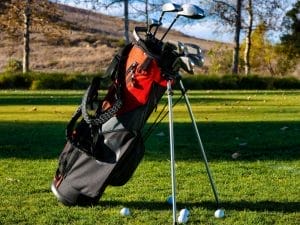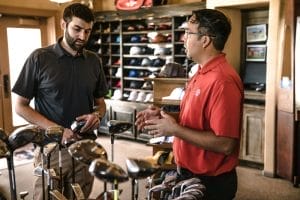Proper care is important if you want to extend the lifespan of your golf clubs and ensure they continue to perform well. Golf clubs can be an expensive investment, and preserving their quality not only saves you money but also helps improve your game. With proper care, your clubs will last longer and perform better round after round.
Clean Your Golf Clubs Regularly: A Simple Yet Essential Step
Regular cleaning is one of the simplest ways to extend the lifespan of your golf clubs. Dirt, moisture, and different weather conditions can quickly accumulate on the clubheads, shafts, and grips. If left unchecked, these particles can cause wear and tear on your clubs. Cleaning your clubs after each round ensures they stay in good condition.
Use a soft brush and warm water for cleaning. This will effectively remove dirt and grime without damaging the clubs. Avoid harsh chemicals or abrasive tools, as these can damage the finish. Neglecting to clean your clubs regularly can lead to rust or scratches on the clubheads and shafts. Regular cleaning helps prevent these issues and keeps your clubs looking and performing like new. Additionally, deep cleaning should be done every few months to remove any persistent buildup. This is especially important for the grooves on the clubface, as buildup can affect the ball’s spin and accuracy.
Capt: Regular cleaning prevents dirt and rust, extending golf club life and ensuring optimal performance
Store Your Golf Clubs Properly: Protect Them from the Elements
Proper storage is key to protecting your golf clubs from the elements and extending their lifespan. To maximize the life of your clubs, avoid exposing them to extreme heat, humidity, or direct sunlight. These conditions can cause damage to the grips, shafts, and clubheads over time.
When storing your clubs, it’s important to know how to maximize space in your storage unit and use every inch of your unit wisely. Whether you have a garage or a dedicated storage area, ensuring the clubs are stored properly is crucial. A golf bag with padded dividers is a great investment to keep your clubs organized and protected. By using a bag with enough space, you can easily maximize space in your storage unit, keeping your clubs safe while avoiding unnecessary stress or scratches. Not to mention, using headcovers for each club will help shield the clubheads from any potential damage. Make sure to store your clubs in a cool, dry place. Extreme temperatures can cause rust on the metal components, so avoid keeping them in places that might get too hot, like a car.
Capt: Proper storage in a padded bag protects your golf clubs from damage and maximizes space
Keep Your Grips in Top Condition: The Overlooked Part of Care
Grips are often overlooked when it comes to club care, but they are critical for maintaining control during play. Worn or slippery grips can negatively affect your swing and accuracy.
In short, you should replace your grips when they become worn or lose their texture. Most golfers wait too long before replacing grips, but early replacement ensures a better grip and improved performance. Also, when on the move, make sure that you pack your golf equipment properly to ensure everything stays safe.
Regularly clean your grips as well. Besides, keeping them free from dirt and moisture helps extend their life. A simple wipe-down after each round can prevent buildup and maintain the grip’s quality.
Another key point is to keep your grips dry during play. Sweat can make them slippery, so using a towel to wipe down the grips during your round is a good habit to develop.
Capt: Replacing worn grips and keeping them clean and dry helps extend the lifespan of your golf clubs and improves performance
Handle Your Clubs with Care: Proper Usage Prevents Damage
Proper handling of your golf clubs can significantly extend their lifespan. Mishandling clubs—such as dropping them or throwing them—can cause damage that is often irreparable. Carefully placing your clubs on the ground after a shot, rather than dropping them, helps avoid unnecessary wear and tear. Always be gentle with the clubs when putting them back into your bag.
Also, avoid using clubs for shots they weren’t designed for. For example, using a driver for a short shot or hitting a rock with your irons can cause permanent damage to the head or shaft. With this in mind, always use the right club for the right shot to reduce stress on the equipment. Not to mention, avoid slamming or dropping clubs, which can cause cracks or other damage.
Get Regular Professional Club Fitting and Maintenance
Regular professional club fittings and maintenance checks can go a long way in extending the lifespan of your golf clubs. Professional technicians can assess your clubs for any issues, such as loose heads, bent shafts, or worn-out grips, and fix them before they get worse.
Another key point is that proper club fitting ensures that your equipment is optimized for your body type and playing style. Over time, the performance of your clubs may decrease if they are not suited to your needs. Regular fitting sessions help ensure that your clubs continue to perform at their best. In contrast, clubs that are not properly fitted can wear out faster. With this in mind, consider having your clubs checked at least once a year or whenever you notice a decline in performance.
Use the Right Course Etiquette: Protecting Your Clubs During Play
Your behavior on the course can also affect the condition of your clubs. Respecting course etiquette helps prevent unnecessary damage. Simple actions like repairing divots and fixing ball marks on the green can reduce the risk of damaging your clubs.
Another key point is to avoid dragging your clubs across the ground, especially in sand traps or rough areas. In short, placing your clubs carefully on the course helps prevent scratches and dents. Besides, following proper course, etiquette also ensures that your clubs stay in good condition. For example, avoid dropping your clubs onto hard surfaces, as this can damage the shafts or heads.
Regularly Inspect Your Clubs for Damage: Preventative Measures Save Money
Inspect golf clubs regularly for any signs of damage, even if you have stored them properly. Look for cracks, dents, or loose parts that may indicate a problem. A small issue can often be fixed early before it becomes a major repair.
With this in mind, check your clubheads, shafts, and grips after every few rounds. Visual inspections can catch problems early, preventing further damage. You can also tap the shaft lightly to listen for any unusual sounds that might indicate a crack. Similarly, keep an eye on the ferrules—the small rings that connect the shaft to the clubhead. They can loosen over time and need to be tightened to maintain the club’s integrity.
Summary: Key Steps to Extend the Lifespan of Your Golf Clubs
To extend the lifespan of your golf clubs, you must focus on regular cleaning, proper storage, and maintaining the grips. These simple steps can prevent rust, scratches, and other damage that shorten the life of your clubs. Professional maintenance and fitting ensure your clubs stay in top shape and continue to perform at their best. Besides, proper handling during play and adhering to course etiquette will reduce unnecessary wear.
Meta: Learn how to extend the lifespan of your golf clubs with proper care. Follow these tips and advice to keep your clubs in top condition.




